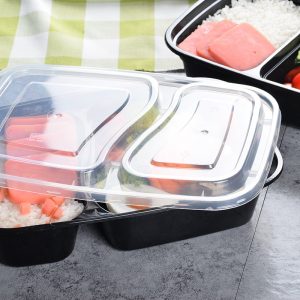Boxed packaging containers made of plastic have many characteristics such as low density, light weight, and easy processing. The appearance can be transparent or opaque. It is widely used in the food packaging industry. Plastic packaging boxes are generally available in the market with three transparent materials: PVC boxes, PP boxes, and PET boxes.
Polyvinyl chloride(PVC)
The English name is Polyvinyl Chloride, or PVC for short. Industrial production of PVC began in 1927. The vinyl chloride monomer (liquid) is obtained from acetylene gas through hydrochloric acid, and then polyvinyl chloride is obtained after polymerization. It is widely used in the production of films, blow-molded bottles, blister packaging, etc.
The performance characteristics of polyvinyl chloride (PVC) are:
(1) Crystalline and transparent. Poor impact resistance and hard (it will become soft after adding plasticizer)
(2) Good aroma and taste retention, excellent barrier to oxygen, water, oil, alcohol, petroleum, and solvents
(3) Not easy to be corroded by acid and alkali
(4) Polarity. Therefore, it has a strong affinity with other additives and can be made into PVC products with different toughness.
(5) It is easily affected by aromatic hydrocarbons, halogenated hydrocarbons, ketones, esters, acids, nitrogen, sulfur, and phosphorus molecules
(6) It will turn yellow when exposed to heat and ultraviolet rays, and will decompose when overheated (136°C) and produce corrosive substances.
(7) The monomer (harmful to human) content in the material is required to be stable, so there are strict restrictions when used in food packaging
(8) When dealing with PVC, there are environmental problems, such as burning PVC will produce HCl (even some people suspect that it produces chlorinated dioxins)


Polyester(PET)
The full name is polyethylene terephthalate, and the English name is Polyester, or PET for short. It is drawn into silk and called polyester, and it can be made into film and tape, etc.
The performance characteristics of polyester (PET) are:
(1) Good transparency, good strength and toughness, low breakage rate, resistance to handling
(2) Good rigidity and surface hardness, tensile strength after orientation (91℃) reaches 210N/mm
(3) Good pressure resistance, low air permeability, suitable for CO2 beverage containers
(4) Can tolerate weak acids, alkalis and most solvents
(5) The gas barrier property is worse than that of PVC, and it has oxygen permeability, so it is not suitable for beer and wine
(6) Not suitable for packaging hot-filled syrup products


Polypropylene(PP)
The English name is Polypropylene, or PP for short. The density is only 0.9g/cm3, which is a light plastic. It has a more complex molecular structure than PE, and 5% of the molecules are arranged irregularly and become an amorphous soft substance in polypropylene resin. Various processing techniques such as thermoforming, blow molding, injection molding, and extrusion can be used, but The processing cycle is longer.
The performance characteristics of polypropylene (PP) are:
(1) The sheet is opaque, the film is crystalline and transparent, and the surface is bright
(2) Low price, elastic and tough, widely used as ribbed bottle caps
(3) With a high melting point, it is suitable for cooking and sterilizing packaging materials
(4) Good rigidity, can be used to make thin-walled containers. Very versatile
(5) Strong ability to withstand repeated salt bending and can be used as a plastic “hinge”
(6) Nucleated polypropylene with certain additives has higher impact strength and higher elongation
(7) Excellent resistance to oil and grease, strong acid (except strong nitric acid), and alkali resistance
(8) Good barrier to water and water vapor, but poor barrier to gas
(9) It can withstand most solvents (except chlorinated hydrocarbons) at room temperature, but at high temperatures, benzene, xylene, toluene, and turpentine will affect it
(10) The low temperature brittleness is obvious, so it has good impact resistance when mixed with other materials such as PE at low temperature.




















